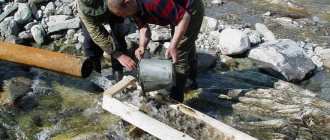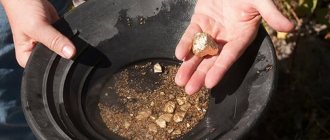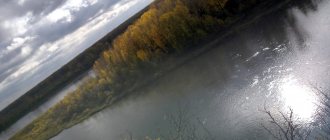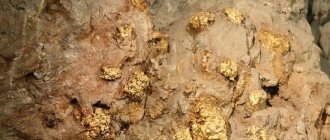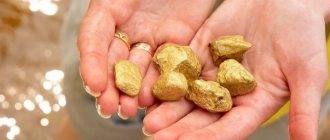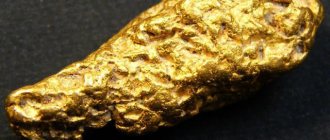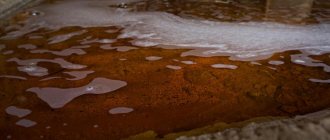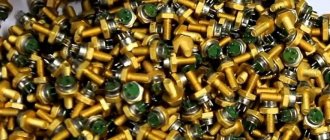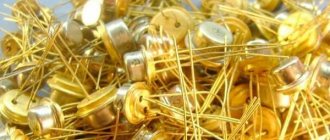Finding gold is hard work. Sometimes months of fruitless efforts and research pass in search. Russia is far from being the last among the countries that have deposits of this precious metal. Moreover, in recent years it has ranked 5th among gold-mining countries. Geologists advise looking for precious metal only where it can be found, and for this there are a large number of ways to find metal in the form of flakes, nuggets, gold sand and placer gold. Precious metal may be found in areas where mining companies have operated.
It can be on the surface layer, in the middle of mountain streams or on a raft, in bedrock, or rock cracks. But you shouldn’t look where searches have never been carried out; the likelihood of finding precious metal there is almost zero. When a person finds even a small pebble of gold, he understands that his labors were not in vain, so he should not be discouraged. Great luck, geological knowledge and a good tool will increase the likelihood of a find many times over.
Basic signs of gold
It is very easy to confuse gold with another mineral if you do not know some of its features. Everyone knows that it is yellow and shiny. But, besides gold, pyrite and chalcopyrite have such characteristics. Nuggets can be yellow with red and greenish hues.
The natural material is malleable and can be forged. It does not oxidize, but dissolves in hydrochloric or nitric acids. If you look for gold in ores, you first need to focus on the fact that the metal grows together with other minerals. It will not clearly crystallize like pyrite and chalcopyrite. The noble metal is often found fused with quartz, appearing like a grain or plate.
Alluvial gold is characterized by grains in the form of hooks or wires. In this form, natural material is found in the form of small grains and various kinds of nuggets. If we consider its dimensions, we can distinguish the following categories:
- finely dispersed (up to 10 microns);
- visible (0.01-4 mm);
- nuggets (from 5 g to 10 kg).
To distinguish it from pyrite and chalcopyrite, you need to pay attention to the color. The pebble is viewed from different angles. From any angle, gold will not change its original shade. Pyrite will give itself away by changing its color. Its bright yellow color will fade to gray upon inspection. Gold can be checked with a knife; it will not crumble like pyrite and chalcopyrite, but it will leave grooves or lines on it.
If doubts have not been dispelled after the procedures, you can test the metal using sulfuric acid. Gold's color will not change, but pyrite and chalcopyrite will change it. Pyrite in areas of impact will turn black, and chalcopyrite will turn red.
Gold dredge
After many years, the technologies used to mine gold in ancient times have not changed much. All that has changed is the work of mechanized machines instead of human labor.
Today, few people are engaged in gold mining using trays, since this method is no longer relevant and widespread. But the technology has survived. Today, many people use a huge machine that has a large number of trays.
A dredge is a device used to flush water from a river. It is this huge and noisy structure that is capable of extracting precious metal from river rock. Although this method is very effective and profitable, it has a very negative impact on the environment. After dredging, river beds are left in a deplorable state. But in order to know how to find and then safely extract gold from the river, it is recommended to use dredging as the easiest way to mine gold.
Precious metal deposits
There are many places where you can find gold. But to a greater extent, gold ores are formed in mountainous and watery places. Near the mountains, in depressions, young gold deposits are found. Gold veins accumulate in places of faults and cracks in mountains, rocks, and are located along the line of mountain rivers. They come from the bowels of the earth through special channels (fault zones and igneous rock dikes). The total length of such veins can reach several hundred meters, and sometimes reach up to 2 km.
In search of gold, prospectors find pure deposits of gold veins and complex places of formation of non-ferrous metals. In the second case, placer deposits of gold are formed due to the properties of the precious metal to dissolve and oxidize under natural conditions. Gold can come into contact with other minerals and form where sulfides and granitoids come into contact with limestone. Vein deposits are located at different depths, so they are divided into 3 categories:
- low temperature;
- medium temperature;
- high temperature.
If there is a placer gold deposit nearby, then there are also vein channels in the area.
The precious metal is sometimes an integral part of the gold-polymetallic zone, then silver, zinc and lead are combined with it. In Cretaceous sedimentary formations, in depressions and conglomerates, gold-bearing veins are found in places of faults and large cracks. In these zones, the metal is found in generations with different types of quartz, sulfides and other minerals. But the largest areas for extracting priceless metal are stockwork areas. Gold, along with sulfides and quartz, is scattered in areas of large cracks in the form of inclusions or veins in the rock. Such deposits can be very long and large. Therefore, in such zones, metal mining is organized industrially, where ordinary miners can search for gold quite effectively after completing all the work.
Top 10 Russian rivers rich in gold reserves
Gold can be found in the following places:
- Lena River basin. Over one and a half hundred years of industrial production, about 1.5 tons of precious metal were mined here. There is still enough gold left in abandoned deposits for private miners.
- Bom River (Amur Region). The yellow metal is found throughout the Bohm. In some places, prospectors find gold deposits where it lies right in the riverbed. Nuggets are often found, the largest reaching 300-400 g.
- Millionny Stream (Amur Region). Placers of gold were accidentally discovered by smugglers at the end of the 19th century. In the first month, we managed to wash about 650 kg of metal.
- Unakha River (Amur Region). Mountain river with fast flow. Gold is found where the bottom is exposed.
- Jalon stream (Amur region). The rich part of the seam (more than 2 kg of gold per 1 ton of sand) has already been developed, but there is still room for enthusiasts with metal detectors.
- Bodaibo River (Irkutsk region). The alluvial gold here is large. There are grains with a diameter of 8 mm or more.
- Bolshoy Chanchik River (Irkutsk region). Tributary of the river Bodaybo. The riverbed has already been dredged, but large nuggets are still found.
- Alekseevsky stream (Kamchatka region). Famous for large nuggets weighing up to 1 kg.
- Talga River (Khabarovsk Territory). It has been exploited since the end of the 19th century, but large nuggets are still found today.
- Sanarka River (Chelyabinsk region). Here were the richest deposits of precious stones and metals, which had been mined since the end of the 19th century. Currently, there is no industrial gold mining in Sanarka.
Those wishing to try themselves as a private miner should remember that they must purchase the appropriate license. Otherwise, fishing will be illegal.
Types of metal deposits
The most common gold deposits are quartz veins, created by nature over many years. Over time, these veins were destroyed by external factors, and both quartz and gold were washed away by sediments into rivers. At the bottom there was a constant movement of stones, which crushed and rolled around the metal. Due to the fact that the noble metal is heavier than other minerals, it was deposited in certain areas of the ducts. With just one glance at the size and degree of rounding of a sample, specialists can determine its travel history and the location of the main vein.
You can successfully search for gold near a river only if the map contains marks on the main places of deposits, which can be both at the bottom of the river and near it. Near the river there are residual deposits formed due to the weathering of the vein. Some pieces of vein and nuggets moved a certain distance from the main location, but did not fall into the pond. These formations are called eluvial. When looking for terraced metal deposits, you can find formations above the water level (old bottom) and at a great distance from the current riverbed, sometimes they are found even high in the mountains. The last place where gold is formed is the bottom of the river, where the metal was washed away by water from the main vein.
Gold is several times heavier than other minerals, so its movement along the bottom occurs only under the strong influence of water masses over short distances. The movement occurs in the area of the river that is between the bends. Large stones become an obstacle to gold, so it is better to look for gold under them at the bottom of the river. As the river widens, the flow speed decreases, so gold can settle in such areas.
Where else can you find jewelry?
There are many places where lost jewelry can be found. You can suddenly find it:
- At work. The lost item can be found among documents, in a desk drawer, in a public restroom, and so on. Sometimes caring colleagues bring lost jewelry. Don't forget to thank them for their honesty!
- In car. Thoroughly search the glove compartment, don't forget to look under the seats and in the trunk. You can take your car to the car wash and have the interior cleaned. There is a small chance that the ring will be returned to you for the promised reward. However, you can walk around the car interior with a vacuum cleaner yourself.
- In a public place. Many people go to gyms, fitness centers, swimming pools and all kinds of clubs wearing jewelry. However, this is not a problem if you don’t forget to put valuables in the safe and take them back.
If you forget your jewelry after training just in your locker, there is little chance of getting it back, but you can try to stress the administrator. If you leave it in the safe, it will be waiting for you safe and sound.
Gold content of quartz
Quartz is the most common mineral and forms in veins with many metals and minerals. In the search for the noble yellow metal, it plays a major role because the appearance of quartz can reveal the location of the gold. To correctly read quartz, knowledge of the properties of the gold-bearing sample is necessary. This mineral comes in a variety of colors and shades; it can be transparent, black, white, or gray. You can search for gold in quartz in several types:
- corn;
- nest;
- veins;
- germination;
- invisible dispersive.
If ore minerals were in quartz, but were leached, then the quartz has signs of sponginess. When the process of sulfide decomposition occurs in a gold-bearing vein, quartz crystals acquire yellow, cherry-red, or shades similar to them, which indicate that the mineral is fermented. If a prospector in search of yellow metal sees banded quartz with powdery layers or with the inclusion of tourmaline and sulfides, it means that representatives of low-temperature or high-temperature layers are somewhere nearby. Such zones may contain gold.
“Gold Rush” in Russia and America
In the 20s of the 19th century, when people realized that finding this fossil was a very real task, a real gold rush began in Russia. Mamin-Sibiryak described it very well in his novel “Gold”. Since the middle of the 19th century, experts found the answer to the question of where to look for gold, and intensive mining of the mineral began in many regions of our country: in Altai, in the Nerchinsky district, in the Belgorod region, in the area of many rivers of Siberia: the Yenisei, Kolyma, Lena, Amur and many others.
At the beginning of the 21st century, the number of gold deposits in Russia totaled 5,800. About 75% of all deposits today are located in Siberia and the Far East of the country. The largest volumes are mined in the Krasnoyarsk, Khabarovsk Territories, Irkutsk, Amur, Sverdlovsk, Magadan regions, the Republic of Sakha and Buryatia, as well as in the Chukotka Autonomous Okrug.
At the end of the 19th century, the gold rush swept across America. In 1896, the New World was shocked by the news that a large deposit had been discovered in the Klondike region. The whole country has come to where the gold is. From there, in less than 100 years, 390 tons of precious metal were exported, the value of which is approximately 4.4 billion US dollars. Then news of places rich in this valuable mineral overtook America at a moment of deepest crisis. The country was then experiencing a huge number of bankruptcies because the economy suffered from stock market surges. Thousands of people have traveled to Alaska in search of gold nuggets. As a result, the gold rush had a good impact on the development of the economy of Western Canada, Alaska, and the northwestern part of the United States.
Yellow metal satellites
Some prospectors, in search of wealth, focus on the companions of gold, and there are many of them. Quartz, adularia, silver, pyrite, galena, platinum - all these minerals are found with gold. The only problem is that the presence of one of the gold satellites in the ore does not always indicate the presence of a noble metal in it. Sometimes gold ores consist of fused quartz, lead and gold, sometimes gold, quartz and antimony, and sometimes a combination of gold, silver, quartz and feldspars.
Even about silver, the most common neighbor of gold, it cannot be said that it always indicates the presence of the yellow metal in ores. But when a nugget is found while searching, it is almost always mixed with silver. In some cases, the share of silver reaches significant figures, but sometimes this part is negligible. The ideal ratio of gold and silver in ores occurs mainly in volcanic zones. They can be in Kamchatka or any other Far Eastern region.
Cyanidation
This least labor-intensive method is based on dissolving gold in hydrocyanic acid. How to extract gold by cyanidation? It is necessary to crush the rock that contains the noble metal, pour it into a waterproof tray, and fill it with hydrocyanic acid, in particular sodium cyanide. It will begin to seep through the rock, dissolving the gold in the process. The resulting solution is poured into a separate container. The gold it contains is precipitated, for example, with zinc dust, and hydrocyanic acid is returned to the process.
Rich places in Russia
Russia is rich in different types of deposits, so you can search for gold in almost all its regions. Skarn, hydrothermal deposits and gold-quartz formations are scattered in different regions of the Russian Federation. Approximate list of areas and types of gold deposits:
- Siberia (Olkhovskoe) - skarn type;
- Ural (Berezovskoye), Transbaikalia (Darasunskoye) - gold-quartz-sulfide formation;
- Pacific ore belt - volcanogenic hydrothermal deposits;
- Transbaikalia (Baleyskoe, Taseevskoe) - gold-quartz-chalcedony-sulfide formation;
- Northeast Russia (Karamkenskoye) - gold-silver-quartz-adularia formation;
- Yakutia, Magadan, Transbaikalia, eastern Siberia - alluvial placers;
- Chukotka, Ural, Magadan, Bodaibo, Amur and Taximo are golden nuggets.
Many geologists are constantly in search of minerals; they skillfully use geological knowledge and can find gold even in places where an industrial base has been operating for many years, and then also miners. Where, it would seem, everything has already been dug up and dug up, people have almost reached the magma, but still 50 g or 100 g of gold can be found.
How to find a ring at home
In most cases, we lose jewelry not just anywhere, but in our own home, where, it would seem, every corner is known. The answer to this phenomenon is simple: at home we relax and are not so vigilant about things. We perform many actions purely mechanically, including putting jewelry in the most incredible places.
Finding a ring lost in an apartment is not so easy, but don’t get discouraged. If you know for sure that a piece of jewelry was lost in your home, there is every chance of finding it sooner or later.
Losing a ring (especially an engagement or wedding ring) is not a very good omen. But if a woman first lost her ring at home and then found it safely, there will be happiness, prosperity and profit. Sometimes this is an omen of strengthening family relationships and even the birth of a child.
Stretch your memory
This same automatism, which we have already mentioned, is the main scourge of all kinds of little things, including jewelry. Many people have the habit of twisting a ring on their finger, taking it off and putting it on, while doing other things: watching TV, surfing social networks, chatting on the phone.
The result of such “combination” is unconscious actions that are difficult to recall in memory.
Jewelry is often removed while cleaning, taking a bath, or washing dishes. If you get distracted at this moment (soup boiled, a child cried, the cat swept your favorite cup off the table) - and it’s very difficult to remember where your favorite decoration might have been. But you have to!
You need to delve into your memory and minutely reconstruct the picture of events in your own feelings. Remember and repeat your own actions - and the loss will certainly be revealed. Quite possibly, in the most visible place!
There is an expression: “blurry look.” Sometimes we look at things and don't notice them. So it is advisable to involve one more person in the search.
Searching secluded places
Remember one thing: you can find a lost gold ring anywhere. So if your memory fails you, you will have to search all the nooks and crannies. It may take more than one day, but if the jewelry is really valuable to you, it will be worth it.
First of all, you should look at:
- In pockets and bag. First of all, you need to carefully examine the things you were wearing on the day the jewelry went missing. The ring can even be found in the pocket of a kitchen apron or robe!
- In all boxes and drawers. There is a high probability of finding jewelry in any of your boxes, in drawers, among documents, work papers, memorable trinkets, children's drawings, and so on.
- In the toilet and bathroom. We often remove jewelry during hygiene procedures (by the way, this is highly recommended if you want to clean your rings less often). As a result, rings fall to the floor, roll behind cabinets, get lost in the pockets of household organizers or among jars of creams.
- In my own bed. It is recommended to remove rings (even engagement and wedding ones) at night. This gives your fingers a rest and restores normal blood circulation. But not only that: you minimize the risk of losing rings, especially large ones.
- In hard to reach places. We often hide jewelry from children and potential hunters of other people's property. If you have already chosen a secluded place, make a note in your memory or show it to a person you trust. Otherwise, lost jewelry is often found under linen, on cabinets and even in refrigerators!
The search must be carried out consistently and methodically, without missing the most incredible places. Otherwise, the process will have to start all over again, which means unnecessary loss of time and nerve cells.
"General" apartment
In this case, we are not talking about ordinary routine cleaning, but about general cleaning, which must be carried out with feeling, sense, and arrangement. Moreover, you must have enough time: any housewife knows that general cleaning takes, at best, a whole day.
Gold ring with cubic zirconia in the SUNLIGHT catalog
This is a very labor-intensive process, especially if you have large living areas, so you can set aside a day for cleaning each room, starting with the most promising rooms from the point of view of our goals.
Before cleaning, be sure to empty the bag (glass, other container provided in the vacuum cleaner for collecting garbage). In an ideal scenario, the ring will ring against the vacuum cleaner pipe and you can stop cleaning. Or you don’t have to stop: cleanliness in the apartment is also a very significant bonus.
If you have children or pets...
Pets sometimes steal their owners' favorite things. All sorts of large birds are especially often guilty of such actions, but sometimes “magpie” habits are observed in cats and dogs. So if it is not possible to find a gold ring at home, you will have to search your pets’ favorite places.
Children really like everything bright and shiny, so it’s worth keeping jewelry out of their reach. The matter is further complicated by the fact that many girls want to be as similar as possible to their mothers, as a result of which they “beautify” with the help of cosmetics, pour out bottles of expensive perfume, and secretly borrow jewelry.
In this case, the loss of jewelry is the least of all evils. Small children have a habit of putting everything in their mouths, and then tragedy is not far away. For children under three years of age, playing with their mother’s jewelry is extremely dangerous!
If you suspect a little thief of stealing a ring, do not rush to scold him and threaten him with all kinds of punishment. The child will be scared, withdrawn, and will not tell you exactly where the jewelry is.
In a calm tone, tell your child that the ring is a very expensive thing and you will be very upset if it is not found. You can promise some kind of incentive for helping them find their favorite piece of jewelry. It could be some kind of tasty treat, a toy, a trip to an amusement park - in a word, something that the child cannot resist.
Gold ring with diamonds (go to the SUNLIGHT catalogue)
Let's become a little bit of a plumber
If you remove rings before washing your hands and other hygiene procedures, there is a high risk that they will slip down the sink, especially if the drain is not protected by a fine-mesh screen. In this case, you will have to call on a representative of the stronger sex for help or try to cope with the problem on your own.
If the system is equipped with a sump (siphon), the chances of finding a ring are quite high. Otherwise, you will most likely have to say goodbye to the decoration: if it does not catch on the corrugation (and this is rare), then the decoration will end up in the general sewer system and its further fate will be unknown. In any case, do not turn on the water under any circumstances!
So, let's look at the procedure:
- We take a bucket or basin and place it under the siphon.
- Unscrew the sump cover (strongly, but carefully so as not to break the system).
- We examine the contents of the lid, all the “good” that has poured into the bucket, and look into the pipes.
- We rejoice at the find, if there is one.
- Screw the lid into place.
If you don’t risk fiddling with the siphon yourself or the lid simply won’t unscrew, you can always invite a plumber. As a last resort, you can ask a neighbor for help.
How to choose a place?
Before starting to look for gold, experienced trackers study a map of the area.
It is necessary to examine the geological composition of the area: what fossils were found, their location and search method. Gold in Russia is found in different forms, but if there are gold placers in the surveyed area, then the place is suitable for survey. This can be either an industrial area or a non-industrial area. It should be noted those areas where industrial bases have worked or where quartz is present in this area. It is necessary to consider the valleys that form the tributary of the river. The valley is divided into 3 parts: upper, middle and lower. It can be noted with greater confidence that gold will have to be looked for in the upper part of the valley, but there have been cases when gold-bearing places were located both in its middle and lower parts.
It is easier to search for gold based on the characteristics of the deposit when the bedrock is not under sediments and sediments. For example, quartz gold-bearing veins appear as ridges and ridges on the surface of the surveyed area. Quartz can also be in the form of placers, blocks and fragments of a characteristic white or brown-red color. If you look for gold in elongated depressions or clearly defined troughs, you can find stockwork ore deposits. When conducting a survey of a steppe area, the search for gold should be carried out in a place where there are the most thickets, or in a place where there are the least amount of them.
How to look for gold correctly
Finding gold is a very long process that can last for years. It is unlikely that in the first days of searching the digger will find something worthwhile. In order to somehow speed up this process and make it more productive, it is recommended to study a large amount of literature that can teach you how to properly organize your searches.
It has already been said that gold is found in quartz strata. To detect them, you need to pay attention to certain signs that are characteristic only of such deposits.
Necessary tool
Attentiveness, geological knowledge and a metal detector can help in the search. This equipment is quite expensive and will quickly pay for itself, but not all models will cope with the task. Moreover, you need to know how to use and set up a metal detector, since it is very sensitive to the soil, which itself will create interference. The metal detector detects large nuggets at shallow depths (up to 1 m), and the smallest ones at a depth of up to 15 cm.
A special feature of working with such products is its excessive sensitivity, which is caused by a large amount of minerals and iron in the soil. The device should not be configured for a specific type of metal; it must be operated in the mode of detecting all metals without exception. Iron, like gold, produces the same sound, so it is better to stop and test the ground rather than continue searching for gold to no avail. It is necessary to listen to the soil using headphones, so you should be extremely attentive to changes in noise.
The number of false signals coming from the ground depends on the sensitivity level setting. When the sensitivity of the metal detector is low, a person hears deeper sounds of ground testing. The result of the work also depends on the ground balance setting. Ideally, the headphones will display background noise as the metal detector probes the soil, the sound may decrease or increase.
To adjust, you need to turn the knob responsible for ground balance. Every 5-7 m you will have to adjust this function, since the mineralization of the soil may be different. To search for large-sized gold on fairly strong mineralized soil, it is necessary to use a negative setting, which will reduce the sensitivity of the metal detector to small nuggets. And, conversely, when searching for small nuggets, the adjustment is made in a positive direction. The best tuning method is a small sample of gold or lead.
When listening to the soil, the metal detector coil should be kept as close to the surface as possible. When a signal occurs, listening is carried out in all directions from the possible location of the nugget. If gold is present, the signal will be heard in all directions, and if the signal is only triggered in a certain direction, then it is not gold. The last step of the test will be to raise the coil above the intended location. If the sound suddenly fades away, it means the signal is false, and this place does not even contain metal.
Where should I send what I find?
At first glance, the most difficult thing seems to be finding gold. But an equally simple task is to find a buyer and properly sell the found gold. At the same time, lose as little money and time as possible.
Ligature scrap and decorations
Handing over scrap gold in Russia is not a problem; in any city there are pawn shops that accept gold from the population. To successfully return the found jewelry, you will need an ID card.
If the found jewelry is still valuable as a product or historical object, you can find a buyer for it who will take it for more than scrap.
Pure metal
Many private miners are in a hurry to get money for nuggets and sell gold to the owner of the enterprise, which previously selected the main gold from the site, at a price of 1500-2000 rubles per gram.
This is extremely unprofitable for a private gold miner. After all, this is the price of buying scrap gold alloyed (broken chains, bracelets, earrings, etc.), and not pure gold.
Even the popular
585 , from which jewelry is made, contains only 58.5% pure precious metal.
One can imagine how much money a private miner loses after spending a lot of time and effort searching for pure gold and selling it at the price of scrap gold.
The same applies to refined gold extracted from radio components and devices.
To profitably sell pure gold, you need to know this:
- The market value of gold at the time of sale.
- The price will be affected by the beautiful appearance of the nuggets. They are often bought by collectors for whom this is important. The highest prices will be paid for pure nuggets without foreign inclusions. Collectors buy beautiful, bright nuggets at a price above the market price.
- The cost of a nugget also depends on the place where it was found . This is an important point for collectors. They will pay more for something found in a little-known deposit.
- Pawn shops , buying ─ this is not the best way to sell gold nuggets; in the best case scenario, only half of their real value will be paid for them. Handing over gold to a refinery, where it is purified from impurities ─ also means losing 20% of its value.
- You can't rush to sell. We must calmly and carefully search for the right buyer, be it a collector or a reseller.
Tray - equipment for beginners
Washing trays are used for taking samples, but those miners who have not yet mastered all the intricacies of searching use the tray as a means of extracting gold.
Professionals work with a metal detector because up to 100 g of gold can be collected in a week of panning. But they are still used today. The choice of tray determines the efficiency and speed of work. It is inconvenient to look for gold with a metal tray. There are greasy hand marks on it; they can only be removed by annealing the tray. The metal is corrosive and cannot be tested with a metal detector or separated from magnetite and gold. All the negative aspects of a metal tray are completely absent from a plastic product, and a green tray is an ideal product in which gold flecks are very clearly visible.
In searches, trays with a diameter of 15-40 cm are used, but a tray with a diameter of 40 cm will weigh approximately 10 kg in use. Therefore, the best option would be a tray with a diameter of 35 cm. In addition to the trays, you need to purchase a plastic sieve (mesh size 12 mm). Rinse should be 300-500 m higher from the river mouth. A good sign would be if at least 1 piece of gold gets into the tray, but if nothing is found during washing, this is not a sign that the stream is hopeless. If there are large nuggets in it, then there will be very few small gold pieces.
Amalgamation
This is one of the oldest and most harmful methods of gold mining, officially prohibited in Russia, but used in other countries by our artisanal gold miners. It involves the use of mercury. How to extract gold by amalgamation? To do this, mercury is added to a plastic or glass tray containing sand and very fine fractions of gold. She will not dissolve the coveted metal, but will draw it into her balls. To help the process, you need to turn the tray, allowing the mercury to roll over the entire surface of the sand. Mercury beads containing gold are called amalgam. It is collected, separated from the sand and subjected to either treatment with hydrochloric acid, in which mercury will dissolve but gold will not, or by evaporating the mercury over a fire. This can be done in a simple frying pan. In acid, the gold freed from mercury settles in flakes to the bottom, after which it is thoroughly washed. If you don’t want to lose mercury, you need to dip a piece of foil into the acid. This simple technique allows the mercury to precipitate. You can extract gold from amalgam by simply filtering it through suede or tarpaulin, but in this case there is always a large loss of expensive metal.
Additional devices
A minidrag is a device that is used in underwater searches. In terms of operation, it resembles a regular vacuum cleaner, comes in different sizes and, accordingly, has different productivity. Small mini-dredges weighing 24 kg are capable of processing 100 kg of material per hour, and large devices weighing 90 kg can process 1000 kg/hour.
A minidrag consists of an engine, a pump, an injector, a flushing chute, a floating system on which all the equipment will be located and sometimes the air supply system will be turned on.
The minidrag sucks material from the river bottom into the injector, which then falls into a washing trough that separates the gold from other materials. Searching for gold in this way is not always easy or simple, because there are a large number of stones, boulders and other obstacles along the way.
The second device that is used in searching for precious metals is a gold probe. This is an electronic device that detects gold on soil and under water. It consists of a probe, at the end of which there is a sensor device, and a control unit is installed on the probe handle. They look for gold in the soil by sticking a probe into the ground, the sensor comes into contact with the metal and produces a certain signal, after which the light turns on. The magnetite probe reacts with a different sound tone and light bulb color. It catches those small gold particles that are inaccessible to a metal detector.
Where is gold found?
The home craftsman needs to be prepared for a labor-intensive and painstaking process, because... the available raw materials have a meager gold content and are difficult to extract. Precious metal can be extracted from the following materials:
- Parts of radio equipment and electronic devices - microcircuits, transistors, diodes, capacitors, resistors, switches, motherboards, connectors, processors. A sufficient amount of gold for extraction is contained in relays such as RES, RPS, RPV, RKG; lamps from old radios and televisions. The GMI series radio tubes stand out in particular. Gold-containing parts can be found in televisions, radios, computers, tape recorders, VCRs, mobile phones, refrigerators and other household appliances. The presence of such parts, as a rule, was indicated in the equipment passport. Modern technologies make it possible to do without the use of precious metals, and therefore they should be looked for in the parts of old instruments and devices. It should be noted that Soviet-made products were distinguished by a large number of valuable parts.
- Costume jewelry . Gold can be extracted from spoiled, damaged, deteriorated earrings, rings, pendants, pendants, brooches and other jewelry that has gilding or inclusions of valuable elements.
- Watch . Of interest are products with coating on the case or hands, and bracelets.
- Cutlery and souvenirs . These can be forks, spoons, dishes, figurines, decorative elements with gold plating.
Interesting: Tsar's gold as an investor's tool: is it profitable to invest in the Nikolaev ruble?
Different search methods
It depends on the area how to look for gold and what method should be used. If the survey area is poorly studied by geologists, and the searches were not carried out in full, it is necessary to use the pebble method. The bed deposits of springs and small rivers are checked with a metal detector. These places are examined for the presence of quartz with traces of precious metal or for the obvious presence of gold. In tributaries of rivers and directly in streams, the survey is carried out from the bottom up: these are the places where quartz pebbles should be looked for and the results recorded on the map. If the metal deposit is close, the number and size of pebbles will increase.
Then the dump search method is used, when a group of prospectors combs the area in search of ore dumps and spills, which are carefully marked on the map. The distance between people should be about 70 m, if the area is densely populated - 15 m. If, while searching the rocks, prospectors come across fragments of quartz rock, then the circle of searches must be narrowed and boundaries set. Quartz samples are examined, and based on their characteristics, the location of the ore body is guessed. To confirm the hypothesis, reconnaissance should be carried out using the trench method.
If there are no ore dumps, then you look for gold using the digging method. The method allows you to search for a crushed vein by gold released to the surface. It will be located on elevations and sediments, so the search will involve several people who go through the digging lines and take sample material from them. The easiest way to take material for washing is from clay crushed stone, which is located under a layer of turf. A few kilograms of material, which is washed in an Asian ladle, is enough. After the material has been washed, it is examined through a magnifying glass and gold particles are looked for. Proper examination and diligence are a guarantee of a successful discovery.
Gold mining in the cold season
It is easier to mine gold in the cold season than in summer
Most miners would prefer gold mining in the warm season, when the result promises to be more tangible and working conditions are much more comfortable. But in reality, searching for metal in winter or early spring has its advantages that cannot be ignored. The main thing is to know where to look. For this method, you must take hunting skis (not cross-country skis) for traveling over rough terrain.
It is much easier to detect and remove valuable metal in clean, clear water in winter than in summer. When searching, you need to take into account that river levels drop significantly in the cold months. Therefore, usually shallow places that are promising for searching during this period become even shallower and more accessible for exploration, and areas of rocks previously covered by water begin to be visible above its surface.
The advantage is the ability to notice yellow reflections simply on the surface of the rocks (an additional tool for beating off pieces of rock will be useful). In addition, in winter you can find the precious metal in larger quantities on the rocks than in the sand in summer.
The right place is the basis for a successful search for the treasure.
